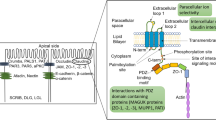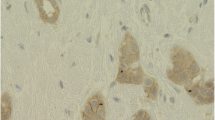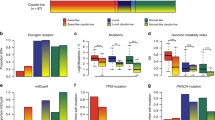Abstract
Adherent and tight junction molecules have been described to contribute to carcinogenesis and tumor progression. Additionally, the group of claudin-low tumors have recently been identified as a molecular subgroup of breast carcinoma. In our study, we examined the expression pattern of claudins, beta-catenin and E-cadherin in invasive ductal (IDCs) and lobular (ILCs) carcinomas and their corresponding lymph node metastases (LNMs). Tissue microarrays of 97 breast samples (60 invasive ductal carcinomas, 37 invasive lobular carcinomas) and their corresponding LNMs have been analyzed immunohistochemically for claudin-1, -2, -3, -4, -5, -7, beta-catenin and E-cadherin expression. The stained slides were digitalized with a slide scanner and the reactions were evaluated semiquantitatively. When compared to LNMs, in the IDC group beta-catenin and claudin-2, -3, -4 and -7 protein expression showed different pattern while claudin-1, -2, -3, -4 and -7 were differently expressed in the ILC group. Lymph node metastases developed a notable increase of claudin-5 expression in both groups. Decrease or loss of claudin-1 and expression of claudin-4 in lymph node metastases correlated with reduced disease-free survival in our patients. According to our observations, the expression of epithelial junctional molecules, especially claudins, is different in primary breast carcinomas compared to their lymph node metastases as demonstrated by immunohistochemistry. Loss of claudin junctional molecules might contribute to tumor progression, and certain claudin expression pattern might be of prognostic relevance.




Similar content being viewed by others
Abbreviations
- CLDN:
-
Claudin (gene)
- CPE:
-
Clostridium perfringens enterotoxin
- EMT:
-
Epithelial–mesenchymal transition
- MET:
-
Mesenchymal–epithelial transition
- IDC:
-
Invasive ductal carcinoma
- ILC:
-
Invasive lobular carcinoma
- LNM:
-
Lymph node metastasis
- PCR:
-
Polymerase chain reaction
- TJ:
-
Tight junction
References
Paul S, Dey A (2008) Wnt signaling and cancer development: therapeutic implication. Neoplasma 55(3):165–176
Morin PJ (1999) Beta-catenin signaling and cancer. Bioessays 21(12):1021–1030
Saldanha G, Ghura V, Potter L et al (2004) Nuclear beta-catenin in basal cell carcinoma correlates with increased proliferation. Br J Dermatol 151(1):157–164
Hashizume R, Koizumi H, Ihara A et al (1996) Expression of beta-catenin in normal breast tissue and breast carcinoma: a comparative study with epithelial cadherin and alpha-catenin. Histopathology 29(2):139–146
De Leeuw WJ, Berx G, Vos CB et al (1997) Simultaneous loss of E-cadherin and catenins in invasive lobular breast cancer and lobular carcinoma in situ. J Pathol 183(4):404–411
Karayiannakis AJ, Nakopoulou L, Gakiopoulou H et al (2001) Expression patterns of beta-catenin in in situ and invasive breast cancer. Eur J Surg Oncol 27(1):31–36
Mastracci TL, Tjan S, Bane AL et al (2005) E-cadherin alterations in atypical lobular hyperplasia and lobular carcinoma in situ of the breast. Mod Pathol 18(6):741–751
Kuroda H, Tamaru J, Takeuchi I et al (2006) Expression of E-cadherin, alpha-catenin, and beta-catenin in tubulolobular carcinoma of the breast. Virchows Arch 448(4):500–505
Furuse M, Fujita K, Hiiragi T et al (1998) Claudin-1 and -2: novel integral membrane proteins localizing at tight junctions with no sequence similarity to occludin. J Cell Biol 141(7):1539–1550
Hewitt KJ, Agarwal R, Morin PJ (2006) The claudin gene family: expression in normal and neoplastic tissues. BMC Cancer 6:186
Kulka J, Tokes AM (2005) Claudin expression in breast tumors. Hum Pathol 36(7):859 (author reply 60)
Morohashi S, Kusumi T, Sato F et al (2007) Decreased expression of claudin-1 correlates with recurrence status in breast cancer. Int J Mol Med 20(2):139–143
Kim TH, Huh JH, Lee S et al (2008) Down-regulation of claudin-2 in breast carcinomas is associated with advanced disease. Histopathology 53(1):48–55
Tokes AM, Kulka J, Paku S et al (2005) Claudin-1, -3 and -4 proteins and mRNA expression in benign and malignant breast lesions: a research study. Breast Cancer Res 7(2):R296–R305
Blackman B, Russell T, Nordeen SK et al (2005) Claudin 7 expression and localization in the normal murine mammary gland and murine mammary tumors. Breast Cancer Res 7(2):R248–R255
Kominsky SL, Argani P, Korz D et al (2003) Loss of the tight junction protein claudin-7 correlates with histological grade in both ductal carcinoma in situ and invasive ductal carcinoma of the breast. Oncogene 22(13):2021–2033
Sauer T, Pedersen MK, Ebeltoft K et al (2005) Reduced expression of claudin-7 in fine needle aspirates from breast carcinomas correlate with grading and metastatic disease. Cytopathology 16(4):193–198
Blanchard AA, Skliris GP, Watson PH et al (2009) Claudins 1, 3, and 4 protein expression in ER negative breast cancer correlates with markers of the basal phenotype. Virchows Arch 454(6):647–656
Kulka J, Szasz AM, Nemeth Z et al (2009) Expression of tight junction protein claudin-4 in basal-like breast carcinomas. Pathol Oncol Res 15(1):59–64
Lanigan F, McKiernan E, Brennan DJ et al (2009) Increased claudin-4 expression is associated with poor prognosis and high tumour grade in breast cancer. Int J Cancer 124(9):2088–2097
Soini Y (2005) Expression of claudins 1, 2, 3, 4, 5 and 7 in various types of tumours. Histopathology 46(5):551–560
Park D, Karesen R, Axcrona U et al (2007) Expression pattern of adhesion molecules (E-cadherin, alpha-, beta-, gamma-catenin and claudin-7), their influence on survival in primary breast carcinoma, and their corresponding axillary lymph node metastasis. APMIS 115(1):52–65
Herschkowitz JI, Simin K, Weigman VJ et al (2007) Identification of conserved gene expression features between murine mammary carcinoma models and human breast tumors. Genome Biol 8(5):R76
Hennessy BT, Gonzalez-Angulo AM, Stemke-Hale K et al (2009) Characterization of a naturally occurring breast cancer subset enriched in epithelial-to-mesenchymal transition and stem cell characteristics. Cancer Res 69(10):4116–4124
Sorlie T, Perou CM, Tibshirani R et al (2001) Gene expression patterns of breast carcinomas distinguish tumor subclasses with clinical implications. Proc Natl Acad Sci USA 98(19):10869–10874
Kulka J, Szasz A, Nemeth Z et al (2009) Expression of tight junction protein claudin-4 in basal-like breast carcinomas. Pathol Oncol Res 15(1):59–64
Eckel-Passow J, Lohse C, Sheinin Y et al (2010) Tissue microarrays: one size does not fit all. Diagn Pathol 5(1):48
Avninder S, Ylaya K, Hewitt S (2008) Tissue microarray: a simple technology that has revolutionized research in pathology. J Postgrad Med 54(2):158–162
Drury S, Salter J, Baehner FL et al (2010) Feasibility of using tissue microarray cores of paraffin-embedded breast cancer tissue for measurement of gene expression: a proof-of-concept study. J Clin Pathol 63(6):513–517
Soini Y (2004) Claudins 2, 3, 4, and 5 in Paget’s disease and breast carcinoma. Hum Pathol 35(12):1531–1536
Chao YC, Pan SH, Yang SC et al (2009) Claudin-1 is a metastasis suppressor and correlates with clinical outcome in lung adenocarcinoma. Am J Respir Crit Care Med 179(2):123–133
Fritzsche FR, Oelrich B, Johannsen M et al (2008) Claudin-1 protein expression is a prognostic marker of patient survival in renal cell carcinomas. Clin Cancer Res 14(21):7035–7042
Higashi Y, Suzuki S, Sakaguchi T et al (2007) Loss of claudin-1 expression correlates with malignancy of hepatocellular carcinoma. J Surg Res 139(1):68–76
Lechpammer M, Resnick MB, Sabo E et al (2008) The diagnostic and prognostic utility of claudin expression in renal cell neoplasms. Mod Pathol 21(11):1320–1329
Resnick MB, Konkin T, Routhier J et al (2005) Claudin-1 is a strong prognostic indicator in stage II colonic cancer: a tissue microarray study. Mod Pathol 18(4):511–518
Lanigan F, McKiernan E, Brennan DJ et al (2008) Increased claudin-4 expression is associated with poor prognosis and high tumour grade in breast cancer. Int J Cancer 124:2088–2097
Krajewska M, Olson AH, Mercola D et al (2007) Claudin-1 immunohistochemistry for distinguishing malignant from benign epithelial lesions of prostate. Prostate 67(9):907–910
Landers KA, Samaratunga H, Teng L et al (2008) Identification of claudin-4 as a marker highly overexpressed in both primary and metastatic prostate cancer. Br J Cancer 99(3):491–501
Wang M, Xue L, Cao Q et al (2009) Expression of Notch1, Jagged1 and beta-catenin and their clinicopathological significance in hepatocellular carcinoma. Neoplasma 56(6):533–541
Orsulic S, Huber O, Aberle H et al (1999) E-cadherin binding prevents beta-catenin nuclear localization and beta-catenin/LEF-1-mediated transactivation. J Cell Sci 112(Pt 8):1237–1245
Birchmeier C, Birchmeier W, Brand-Saberi B (1996) Epithelial–mesenchymal transitions in cancer progression. Acta Anat 156(3):217–226
Yang J, Weinberg RA (2008) Epithelial–mesenchymal transition: at the crossroads of development and tumor metastasis. Dev Cell 14(6):818–829
Hugo H, Ackland ML, Blick T et al (2007) Epithelial–mesenchymal and mesenchymal–epithelial transitions in carcinoma progression. J Cell Physiol 213(2):374–383
Huber MA, Kraut N, Beug H (2005) Molecular requirements for epithelial–mesenchymal transition during tumor progression. Curr Opin Cell Biol 17(5):548–558
Thiery JP, Acloque H, Huang RY et al (2009) Epithelial–mesenchymal transitions in development and disease. Cell 139(5):871–890
Onder TT, Gupta PB, Mani SA et al (2008) Loss of E-cadherin promotes metastasis via multiple downstream transcriptional pathways. Cancer Res 68(10):3645–3654
Creighton CJ, Chang JC, Rosen JM Epithelial–mesenchymal transition (EMT) in tumor-initiating cells and its clinical implications in breast cancer. J Mammary Gland Biol Neoplasia
Perou C (2009) Overview of gene expression profiling and novel translational technologies in breast cancer. Cancer Res 69(24_Meeting Abstracts):ES3-1
Szasz AM, Micsinai M, Tokes A et al (2009) Proteomic profiling of breast carcinomas based on claudin expression pattern. Cancer Res 69(24_Meeting Abstracts):6123
Hanahan D, Weinberg RA (2000) The hallmarks of cancer. Cell 100(1):57–70
Yoshida R, Kimura N, Harada Y et al (2001) The loss of E-cadherin, alpha- and beta-catenin expression is associated with metastasis and poor prognosis in invasive breast cancer. Int J Oncol 18(3):513–520
Bukholm IK, Nesland JM, Karesen R et al (1998) E-cadherin and alpha-, beta-, and gamma-catenin protein expression in relation to metastasis in human breast carcinoma. J Pathol 185(3):262–266
Cowin P, Rowlands TM, Hatsell SJ (2005) Cadherins and catenins in breast cancer. Curr Opin Cell Biol 17(5):499–508
Goyal A, Martin TA, Mansel RE et al (2008) Real time PCR analyses of expression of E-cadherin, alpha-, beta- and gamma-catenin in human breast cancer for predicting clinical outcome. World J Surg Oncol 6:56
Gyorffy H, Holczbauer A, Nagy P et al (2005) Claudin expression in Barrett’s esophagus and adenocarcinoma. Virchows Arch 447(6):961–968
Lodi C, Szabo E, Holczbauer A et al (2006) Claudin-4 differentiates biliary tract cancers from hepatocellular carcinomas. Mod Pathol 19(3):460–469
Szabo I, Kiss A, Schaff Z et al (2009) Claudins as diagnostic and prognostic markers in gynecological cancer. Histol Histopathol 24(12):1607–1615
Acknowledgments
The authors thank the kind help of Azumah Francisné, Pekár Zoltánné and Samodai Erika in the preparation of slides and immunohistochemistry. The study was supported by the following grants: ETT-049/2006, OTKA-49559/2005, Rosztóczy Foundation.
Conflict of interests
The authors have no interests to disclose.
Author information
Authors and Affiliations
Corresponding author
Additional information
Attila Marcell Szasz and Anna-Maria Tokes are the authors contributed equally to the work.
Electronic supplementary material
Below is the link to the electronic supplementary material.
Rights and permissions
About this article
Cite this article
Szasz, A.M., Tokes, A.M., Micsinai, M. et al. Prognostic significance of claudin expression changes in breast cancer with regional lymph node metastasis. Clin Exp Metastasis 28, 55–63 (2011). https://doi.org/10.1007/s10585-010-9357-5
Received:
Accepted:
Published:
Issue Date:
DOI: https://doi.org/10.1007/s10585-010-9357-5




